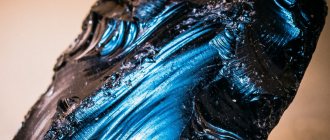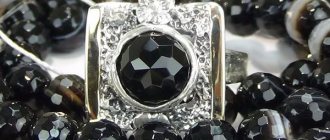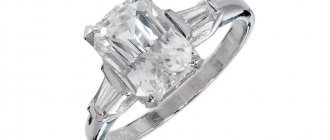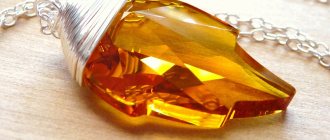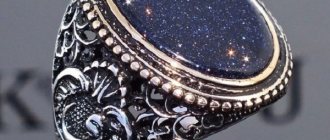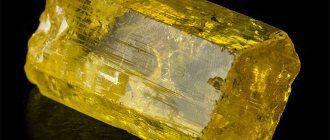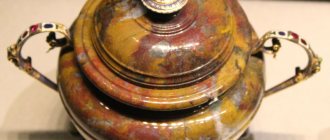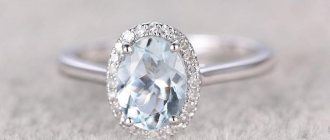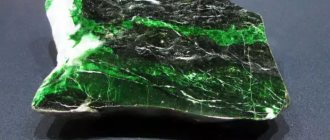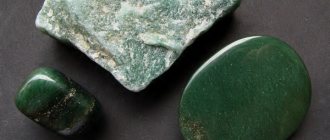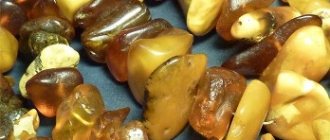Description of artificial sapphire
Synthetic sapphire is obtained artificially.
This sapphire has an even color and bright shine. There are no chips, cracks, natural inclusions or other defects that natural gems have. In mineralogy, sapphires are stones that are exclusively blue in color. Sapphire corundums can be either transparent or colored in different colors, mainly blue and dark blue.
Nanosapphire is not afraid of temperature effects, ultraviolet rays, and lends itself well to cutting. When selling jewelry with such a stone, it must be marked “g/t” or “synthetic,” indicating the artificial origin of the stone. If the mark is missing, the seller is breaking the law by selling artificial stones under the guise of natural minerals.
Varieties and colors
Synthetically produced stone is colorless. It is called leucosapphire. The high strength, heat resistance, and transparency of the mineral allow it to be used in industry in the production of microcircuits, LEDs, and screens in mobile devices.
In jewelry, colored varieties of corundum are more often used. The most common sapphires are blue and light blue, because... they more faithfully imitate the original.
Other shades are also available:
- pink;
- orange;
- yellow;
- green;
- violet;
- black.
In jewelry, there are various shades of sapphires.
Scientists have learned to grow synthetic star sapphire. This stone creates an unusual optical effect.
When illuminated, a light spot with rays diverging in different directions can be seen on the surface of the gem.
Magic properties
Hydrothermal sapphires do not differ in magical properties from natural stones, since all natural ingredients are also involved in their creation. Since ancient times, sapphire was considered a stone for contemplation, pacifying passions and gaining peace of mind. That's why it was also called the "monk's stone"
Modern astrologers are inclined to believe that the magical properties of a mineral depend on its color:
- Shades of blue – wisdom, purity, luck. Magicians use it to predict the future.
- White (artificially discolored) – sincerity, purity, achievement of goals, realization of abilities.
- Yellow is a talisman against all sorts of negativity, adds determination and courage, and promotes mutual understanding between spouses.
- Star - helps overcome blues and depression. A black stone will help men become more attractive in the eyes of the opposite sex and increase potency. This is a talisman for attracting material values and making the right decisions.
- Green – brings goodwill and condescension.
- Pink – openness, emotionality, fulfillment of desires.
We recommend: FIANIT - a laser part and a “poor man’s diamond”
Regardless of the shade, sapphires bring peace, purity and well-being to their owners.
History of creation
The first attempts to create artificial sapphire were made by the French chemist Auguste Verneuil in 1886. After 16 years, he managed to obtain a single crystal by melting metal oxides in a burner fire at a certain temperature and then cooling them.
Later, Verneuil's home laboratory turned into industrial production, which began to produce up to 3 tons of corundum per year. This method of producing artificial stones, called the Verneuil method (process), is still used to this day.
History of the invention of stone
Sapphire is a rare find in nature, its reserves are limited. Known since ancient times, the stone remains popular to this day. By the end of the 19th century, the problem became acute. This required replenishing the jewelry market with new jewelry.
Many chemists and physicists dealt with the issue of creating artificial stone. As a result, in 1907, Verneuil managed to grow a crystal under artificial conditions. To do this, he used aluminum oxide and a torch flame. Synthetic sapphires are still produced in laboratories using the Verneuil method.
Methods for producing artificial crystals
Nanosapphires are synthesized on an industrial scale around the world. In addition to the Verneuil method, other technologies are also used.
The Kyropoulos method is based on growing corundum from molten aluminum oxide. The seed crystal is immersed in a liquid medium, where its growth begins with the help of heating. It is gradually pulled out of the melt, continuously rotating around its axis.
Synthetic sapphires are synthesized all over the world.
Other methods for producing sapphires from melt (Czochralski, Stepanov) are based on moving a crystal or container in a temperature gradient field. With this method, the temperature values of the melt are equal to or slightly higher than the melting point. The lower part of the seed crystal is constantly in contact with the melt. The crystal grows down around the seed and is pulled out into a monolithic cylinder.
Post-cultivation treatment
To prevent cracking, the resulting sapphires are subjected to post-growth annealing in special installations. Subsequently, they are given the desired shape using laser grinding and polishing with suspensions and pastes. Due to the fragility of the material, processing using lathes, drilling and grinding machines is not used.
Synthetic sapphires are colored and refined using various technologies: diffuse treatment with metal salts, heating, and ultraviolet irradiation.
Types and colors of stone
Initially, synthetic laboratory stones, like natural stones, are colorless (leucosapphires). By adding impurities, the desired color can be achieved. Synthetic sapphire shades and additives:
- blue, blue, violet, cornflower blue – iron and titanium;
- pink, red, burgundy, orange-pink – vanadium, chromium, titanium;
- green – chrome tourmaline;
- white – no impurities;
- yellow – beryllium.
Scientists have learned to grow synthetic star sapphire. These are stones that have an asterism effect - if you look through it into the light, you get the impression that there are clusters of stars inside.
Changing the shade or improving the appearance of a gem is aimed at increasing its cost and commercial qualities. This is done through various influences:
- Diffusion is the ability of some substances to penetrate into the composition of other compounds, replacing the original molecules. The crystals are treated with beryllium salts under high pressure and temperature, resulting in an enhanced asterism effect. Such stones are called diffusion stones.
- Ultraviolet irradiation makes the color richer and thicker. This is a refined sapphire.
- Heating to 1500–2000 °C. This is also a method of refining a gem, in which the color of the mineral changes, for example, from pink to blue.
Diffusion and refined sapphires are very similar to natural minerals; only an experienced jeweler can suspect the treatment.
Separately, there is declassified sapphire - a mineral of natural origin, but of low quality, which is why it cannot be assigned to any specific class in terms of transparency or color. Opaque, with dark inclusions, nondescript, it does not look like the usual beautiful crystal.
View this post on Instagram
Posted by Jewelermag (@uvelirmag) Jul 9, 2021 at 2:29 PDT
Properties of artificial sapphire
Artificially grown corundum is similar in appearance to real stone and has an identical crystal structure. It has high strength and high shine. The degree of transparency of stones can vary: from transparent colorless (leucosapphire) to opaque black.
Physico-chemical
The main structural element of synthetic corundum is aluminum oxide. The relative surface hardness value is 9 points on the ten-point Mohs scale. Density - 3.93 g/cm³. Melting point is above 2000 ºC. The mineral reacts chemically with acids and dissolves in them.
Aluminum oxide is the main structural element of sapphire.
Medicinal
Like many gems, sapphire has medicinal properties and is used in alternative medicine. It affects both the physical and spiritual state of a person.
It is believed that the mineral helps with diseases of the musculoskeletal system and diseases of the circulatory system. Wearing amulets with this stone improves vision and hearing, and helps get rid of skin pathologies. Constant contact with sapphire improves mood, reduces symptoms of apathy and depression, and relieves insomnia.
Magical
Blue corundum is a symbol of fidelity, chastity and modesty. It helps its owner find love and improve relationships with a marriage partner. Sapphire is a protector from negative otherworldly phenomena: the evil eye, damage, love spells. It also protects from the influence of envious people, gossips and slanderers. The gem gives determination and courage to an insecure person.
The mineral is believed to have powerful positive energy. It helps to develop the best human qualities: kindness, responsiveness, compassion. It gives inspiration to creative people and stimulates them to search for non-standard approaches to implementing projects.
Blue corundum will protect against the evil eye and damage.
Blue sapphire is the main symbol of the 45th wedding anniversary.
On this day, spouses exchange wedding rings with inserts made of this mineral.
Diffusion refinement of corundums: sapphires and rubies
Rubies and sapphires have been, for many centuries, perhaps one of the most beloved stones on any jewelry market. And Russia is no exception. Ruby and sapphire are varieties of the mineral corundum. Along with natural stones, synthetic rubies and sapphires are used, as well as those subjected to various types of refining (heat treatment, heat treatment with the use of chemical additives (fluxes), various types of diffusion processing, filling cracks and cavities with glass, staining and oiling, coating). It is refined stones that often give gemologists the most trouble during diagnosis.
Let us consider diffusion-improved corundum. Diffusion treatment involves the introduction of color-causing atoms that penetrate the stone from an external source. If movement occurs within the volume of the stone, no matter how shallow it penetrates, then this phenomenon is more correctly called volumetric diffusion, or diffusion into the crystal lattice. Elements diffuse into the gemstone lattice from external sources to create color or create an asterism effect. These may be titanium and chromium or lighter elements such as beryllium.
It must be remembered that, according to Russian legislation, these stones are classified as precious . For rubies and sapphires refined by diffusion, there is an organization standard “Sapphires, rubies, refined, diffusion and/or filled with glass (faceted inserts). Technical conditions. STO13”, which refers to the regulatory and technical documentation of the Federal Treasury Institution “State Institution for the Formation of the State Fund of Precious Metals and Precious Stones of the Russian Federation, Storage, Release and Use of Precious Metals and Precious Stones” (Gokhran of Russia).
This standard applies to natural sapphires refined by diffusion and/or glass filled, natural rubies (faceted inserts) (designated as D/S rubies/sapphires). The standard establishes the main quality indicators used for classification, certification and sorting of sapphires/rubies D/S in accordance with the norms of current legislation.
According to the above standard, refining is the artificial treatment of gemstones and organic substances to change their properties and appearance through coating, crack filling, heat, irradiation and other physical and/or chemical treatments.
To describe rubies and sapphires refined by diffusion, the following designations are used in the standard: Sapphire/ruby, refined by diffusion (sapphire D, ruby D), is a natural sapphire/ruby that has undergone a combined refinement using high temperatures and chemicals, causing the penetration of chemical elements into surface layers to change color and/or optical effect.
Diffusion-improved corundum first appeared on the world market in the late 1970s. This process was radically different from all earlier methods of heat treatment of corundums in that diffusion created an outer thin layer of deep blue color on the colorless or pale colored sapphire. The process was the first successful attempt to add color from an external source. The technology was developed by Union Carbide Corporation. It is possible that processors in Thailand also used this process. Almost all sapphires processed by this method had a blue color (due to the diffusion of titanium). During diffusion processing with the introduction of titanium into the crystal lattice, a shallow near-surface layer is colored to a depth of about 0.4–0.6 mm.
Blue sapphires subjected to this type of refining may have an unusual “watery” appearance; they lack the pronounced zoning of color characteristic of sapphires with an outwardly saturated color. Treated sapphires can be easily identified by their uneven coloration, which can appear mottled due to the fact that the induced colored layer can be partially or even completely removed during repolishing. In addition, there is a concentration of color along the ribs and along the girdle, as well as a concentration of color around pits and cracks reaching the surface (so-called “abrasions”).
Titanium diffusion treatments can also be found in synthetic sapphires. Such stones sometimes exhibit curvilinear color zoning and small gas bubbles, typical of synthetic stones grown by the Verneuil method, as well as color inhomogeneity on different faces, which is characteristic of diffusion processing. But it is worth remembering that a diffusion layer can also be created on colorless synthetic corundum. In this case, curvilinear zoning will not be detected.
Diffusion fining is more difficult to identify in cabochons compared to faceted stones because there are no edges where color variations can be seen. In cabochons, this treatment is best diagnosed by the concentration of color along the girdle.
Diffusion treatment can also be used to induce asterism by adding titanium oxide to the surface layer of the stone. This treatment is identified by an unnaturally clear “star”, uneven color and “color abrasions” in pits, cavities and cracks. In some stones, inducing the effect of asterism may also be accompanied by an intensification of color.
Rarely on the market are blue natural or synthetic sapphires processed by cobalt diffusion. They have a somewhat unnatural color and very high refractive index values.
In 1993, GIA researchers reported the experimental preparation of "diffusion-treated" red corundums. The experiment can be considered unsuccessful, since the depth of the painted layer was very small, and the painted layer was often almost completely removed during repolishing. The color of the stones was dull and the coloring looked uneven.
Rice. 1. Spotting of color and unequal color of different facets in corundum refined by the diffusion method [5]
In the early 2000s. A new beautification method has been developed in Chanthaburi, Thailand, to transform bluish-red stones from the Songea mine in Tanzania into an attractive orange or red-orange color. This method can change the color in light yellow, yellowish orange, pink, brownish, purplish red, blue, purple, green, brown, gray stones. As a result of this processing, a yellow-colored surface layer is created, and, depending on the original color of the stone, corundums of bright yellow, orange, orangish-pink or orangish-red color are obtained. This process can also be used to brighten dark blue sapphires. It is possible to obtain colorless, green, purple stones.
Rice. 2. The beryllium diffusion process can affect many colors in corundum, including rubies and sapphires. Beryllium diffusion cut stones shown range in size from 0.40 to 5.05 carats [1]
Diagnosis of beryllium-treated corundum using standard gemological instruments is difficult. The only visual sign is the presence of a color zone along the contour of the stone: yellow, orange when processing red stones, or colorless when processing blue sapphires. The depth of the painted area varies depending on the processing time and can reach the entire depth of the stone.
The high probability of processing the stone using the beryllium diffusion method is indicated by strong changes in internal inclusions, which have not been observed before in heat-treated stones. For example, zircon inclusions take on the appearance of whitish, shapeless clusters, often containing gas bubbles, and in the cracks that form around them, characteristic tree-like structures of melt crystallization are observed; blue halos of internal diffusion appear around rutile inclusions, which are extremely rarely observed in yellow heat-treated sapphires from the Rock Creek deposit (Montana).
When light elements (beryllium) are used, the treatment is not easily detectable, since the penetration of the diffuse layer may be throughout the depth of the stone and the elements causing the coloration may not be detected by standard chemical analysis techniques. Detection of lighter elements (Be or lithium) is only possible using more sensitive analytical methods such as LA-IPC-MS (laser ablation inductively coupled plasma mass spectrometry), SIMS (secondary ion mass spectrometry) or LIBS ( laser-induced breakdown method).
Authors
Khomrach Margarita Vladimirovna, head. laboratory and associate professor of the Autonomous non-profit organization of additional professional education "Gemological Institute", Graduate Gemologist GIA (+7,; e-mail: [email protected] ; URL: www.gemology-edu.ru)
Romanova Ekaterina Ivanovna, associate professor of the Autonomous non-profit organization of additional professional education "Gemological Institute", associate professor of the department of gemology MGRI-RGGRU, Graduate Gemologist (+7,; e-mail; URL: www.gemology-edu.ru)
List of used literature
1. John L. Emmett, K. Scarratt et al. (2003) “Beryllium Diffusion of Ruby and Sapphire. Gems&Gemology, Vol.39, No.2, pp. 84-135. 2. Michael S. Krzemnicki, Henry A. Hanni, Roy A. Walters. (2004) “A New Method for Detecting Be Diffusion-Treated Sapphires: Laser-Induced Breakdown Spectroscopy (LIBS). Gems&Gemology, Vol.40, No.4, pp. 314-322. 3. Robert E. Kane, Robert C. Kammerling, John I. Koivula, James E. Shigley, and Emmanuel Fritsch “The identification of blue diffusion-treated sapphires” Gems & Gemology, Summer 1990, pp. 115-133. 4. Shane F. McClure, Robert C. Kammerling, and Emmanuel Fritsch, “Update on diffusion-treated corundum: red and other colors,” Gems &. Gemology, Spring 1993, pp. 16-29. 5. Gübelin EJ Koivula JI Photoatlas of inclusions in Gemstones, vol. 2, Opinio Publishers, Basel, Swizerland, 2005. 6. Organizational standard “Sapphires, rubies, refined, diffusion and/or filled with glass (faceted inserts). Technical conditions. STO13".
Areas of application
In addition to the jewelry industry, nanosapphires are also used in other areas:
- Medicine . Leucosapphires are used as a material for the manufacture of surgical blades, artificial eye lenses, optical elements of diagnostic devices, and braces in dentistry.
- Optical industry . Nanosapphire is a raw material for the production of large-sized optics, protective glasses, lenses, and prisms.
- Instrument making . The synthetic mineral is used as substrates for semiconductor microcircuits and optoelectronic devices.
- Laser technology . The mineral is used to produce titanium-sapphire lasers and amplifiers.
- Aviation and Rocket Science . The hard stone is used to make thin, impact-resistant glass for aircraft and space station windows.
In construction, sapphire is used to produce new generation thermal insulation materials.
Jewelry with synthetic stone
Artificially grown stones can reduce the cost of jewelry with inserts. In terms of their structure and physicochemical properties, they are complete analogues of natural minerals. Externally they are even superior to the original.
Jewelry with synthetic stones can reduce the cost of the product.
Natural rocks do not always have a smooth surface without cracks and foreign inclusions. Sapphire corundum is free from all these disadvantages: jewelry with such stones looks more attractive from an aesthetic point of view.
What to look for when choosing
When purchasing a product with sapphire corundum, you need to pay attention to the tag, which should indicate information about the artificial origin of the mineral. The stone is best viewed in good light under a magnifying glass. The crystal grown in the laboratory has an even color and is transparent. The only foreign inclusions that can be seen are air bubbles.
How to wear and care
Nanosapphires are durable and resistant to mechanical stress, so they do not require special care. When dirty, clean them with running water or soapy water, and then wipe with a soft cloth. It is better to store items with sapphires in a separate fabric bag, since due to the high strength of the stone they can damage other jewelry.
Corundums should not be thrown or dropped. Despite their hardness, microcracks may appear in them, which subsequently leads to destruction. Chips on the surface spoil the appearance of the products.
WHAT TO PAY ATTENTION TO WHEN CHOOSING
Artificial sapphires are also cut, due to which the artistic component of the product appears. To avoid purchasing a fake, you should pay attention to the cost of the stone and the designations on the jewelry tags.
Important! Hydrothermal jewelry inserts cannot be labeled with clarity and color characteristics expressed in numbers, unlike natural stones.
The presence of abbreviations “cor.” or "about." indicates that the sapphire is of synthetic origin.
Visual and mechanical differences from natural ones
Synthetic sapphires are visually quite difficult to distinguish from natural ones.
But still, the properties of natural stone and artificial sapphire are different:
- With ideal transparency, purity and shine of GT stone, the natural mineral is dull with some inclusions and microcracks.
- Nanocrystals may have microscopic pimples.
- Natural stone is harder.
2 ways to find differences:
- By the refraction of light on a refractometer.
- Using immersion liquid. The container with it and the crystal should be placed on white paper and examined for inclusions, zoning and stripes.
Doublets with natural sapphires
Doublets are composite stones made up of 2 layers. A thin plate of real sapphire forms the top layer, and an artificial mineral or a cheap imitation of it is glued underneath it. Doublets are often made from damaged stones when it is necessary to hide defects.
Doublets are made from damaged stones.
The glue is selected so that it matches the color of both the top and bottom layers. You can identify a doublet using a magnifying glass. It is enough to look at the stone from the side to detect the border between the two halves.
Sapphires with optical effects
As you know, sapphires that have noticeable optical effects, most often a star in the center of the stone, have a high price and popularity. They are cabochon-cut to highlight the beauty of the phenomenon, and many wonder whether such stones are treated.
Raw corundums of natural origin contain thin needles of rutile in the form of whiskers. Effects such as silk, which looks like a spread of thin needles throughout the thickness of the stone, as well as asterism and cat's eye appear due to the heating of these stones. This happens due to the dissolution of the rutile whiskers and the release of empty tubules from under them.
If the stones are processed in a cabochon with hexagonal symmetry with the lower base perpendicular to the axis of the hexagonal cell, this leads to this effect. It turns out that if the rutile from the tubules is not dissolved, then they are almost invisible. In order to display these effects clearly, it is necessary to heat treat the mineral.
Thus, when purchasing star corundum, you can be sure that it is processed. Otherwise, the star appears barely and is very blurry. If the stone initially contained a lot of rutile, then it was simply heated in borosilicate flux; if there was little rutile, then titanium oxide was added to the flux. The main thing here is the orientation perpendicular to the main axis of the crystal.
Many buyers are assured of the natural origin of the mineral, which has a clearly visible star. Moreover, you can often hear that such high-quality and untreated stone can only be purchased from them, while the rest sell diffusion stones. You should not believe such a statement. In any case, the stone is processed, and if not, then it is most likely synthetic.
Other imitations of natural corundum
Synthetic corundum is a structural analogue of a natural crystal, but differs from it in the chemical composition and content of microimpurities. From an aesthetic and practical point of view, it is the most acceptable copy of natural sapphire.
Natural imitations of opaque sapphire include specimens obtained from waste natural stones by gluing or pressing. This group also includes colored natural minerals of other rocks.
Cheap fakes are made from glass alloys, which contain metal oxides to obtain the desired color.
Opaque stones are imitated using colored plastics.
How to distinguish natural sapphire from imitation
Only an expert can distinguish a natural sapphire from sapphire corundum or a skillfully made fake. In order not to make a mistake with your choice, you should purchase jewelry in reliable stores, check the labeling, and ask the seller clarifying questions.
It is difficult to distinguish natural sapphire from imitation.
The artificial origin of the stone can be revealed by microscopic air bubbles or dust particles that got inside the crystal during its growth. High-quality doublets are difficult to recognize, since the gluing area is often hidden by the frame.
Mechanical impact
The surface of natural sapphires, like their lab-grown counterparts, is free from scratches from sharp objects. It’s easy to scratch a cheap glass or plastic fake.
The place where the doublet is glued will appear more clearly if you immerse the stone in an oily liquid. In this case, the boundaries of 2 interconnected rocks will take on a different shade.
Official methods
Microscopic examination reveals differences between natural and artificial corundum. A growth structure uncharacteristic of natural formation is revealed by a synthetic stone. Titanium impurities are often added to nanosapphires, which give them a blue or blue color. Under the light of an ultraviolet lamp, the artificial analogue acquires a greenish tint, which indicates the presence of foreign impurities.
Similarity to natural sapphires
Hydrothermal sapphires
Hydrothermal sapphires are made from corundum. Another name for this method of growing minerals is nanosapphire. (Often on labels you can find the name of the insert “corundum” and depending on the color it will be synthetic sapphire - blue or ruby - red).
Both natural and hydrothermal minerals have the same chemical formula - aluminum oxide - Al2O3 (corundum).
They have the same hardness on the Mohs scale, 9 out of 10 points. Identical properties in terms of the fragility of the mineral, which causes difficulties in its jewelry processing.
Which sapphire is better to choose: natural or synthetic
Natural stones are several times more expensive than their synthetic counterparts. This is explained by the cost of products, which includes production and sales costs. Deposits of natural minerals are drying up every year. In addition, large resources are spent on mining gems, which also increases the final cost of jewelry.
Natural stones are very expensive.
The production of synthetic corundum is cheaper. But this does not mean that the stone obtained artificially is worse. It often looks more aesthetically pleasing than the original and has brighter colors. In structure and composition it is identical to natural minerals.
Advantages and disadvantages
Nanosapphires have their positive and negative sides.
The advantages of synthetic corundum include:
- smooth surface without cracks or foreign inclusions;
- saturated color;
- resistance to scratches, ultraviolet radiation, and most detergents;
- low cost.
The only disadvantages can be considered the laboratory origin of the stone and its ideal appearance. Awareness of authenticity is important to many people, so some imperfections in natural breeds will be an advantage for them.
Signs of diffusion treatment
In order not to get caught and not to purchase a diffusion sapphire at the price of a natural one, you need to know the methods of distinguishing and the characteristics of processed sapphires.
First of all, we will talk about heated stones, since this method of processing can also be classified as diffusion, but not external, but internal, when the coloring pigment spreads throughout the thickness of the stone. Signs of this are:
- Corundums have a blue tint and have uniform clouding of the crystal with microdefects that will only be noticeable through a magnifying glass with 20x magnification. Around such microdefects, halos, spherical, flat, and others can be formed.
- Heat-treated sapphires and rubies contain local, heterogeneously distributed clouds of halo and red wool.
- Sometimes the result of thermal annealing is also the healing of microscopic cracks, in which case, at high magnification, drops of flux can be seen in them. There may be white tubules from dissolved rutile.
Signs of diffusion treatment are:
- The diffusion of titanium in some cases is manifested by the expansion of star rays in corundums with the effect of asterism. Blue surface diffusion sapphires have a specific color that hardly changes under different lights.
- Beryllium leaves only one trace, and not always. Around the rudiment of the processed stone, you can see an outline of a different color, neighboring on the spectrum. The absence of such a contour does not indicate untreated sapphire, but its presence clearly indicates treatment with beryllium.
- There are no signs of lithium tinting of corundum, visible without instruments.
In most cases, there is nothing wrong with diffusion treatment of sapphire. If this is done with high quality and at the highest level, and lithium and beryllium were used for coloring, then such an effect will be completely unnoticeable. The disadvantage is that red ruby and blue sapphire cannot be produced with these substances, and the methods used to dye corundums in these colors have less long-term effects.
Useful tips
You should choose jewelry with sapphires based on your own preferences and financial capabilities. Those who believe in the magical and healing properties of stones should purchase real gems. It is believed that only they have supernatural powers. When purchasing natural stone, you should ask the seller for documents confirming its authenticity.
People who value, above all, an attractive appearance and the absence of flaws in stones, are more suitable for artificial sapphires. Purchasing jewelry with such corundum is a good option for those who want to save money.
